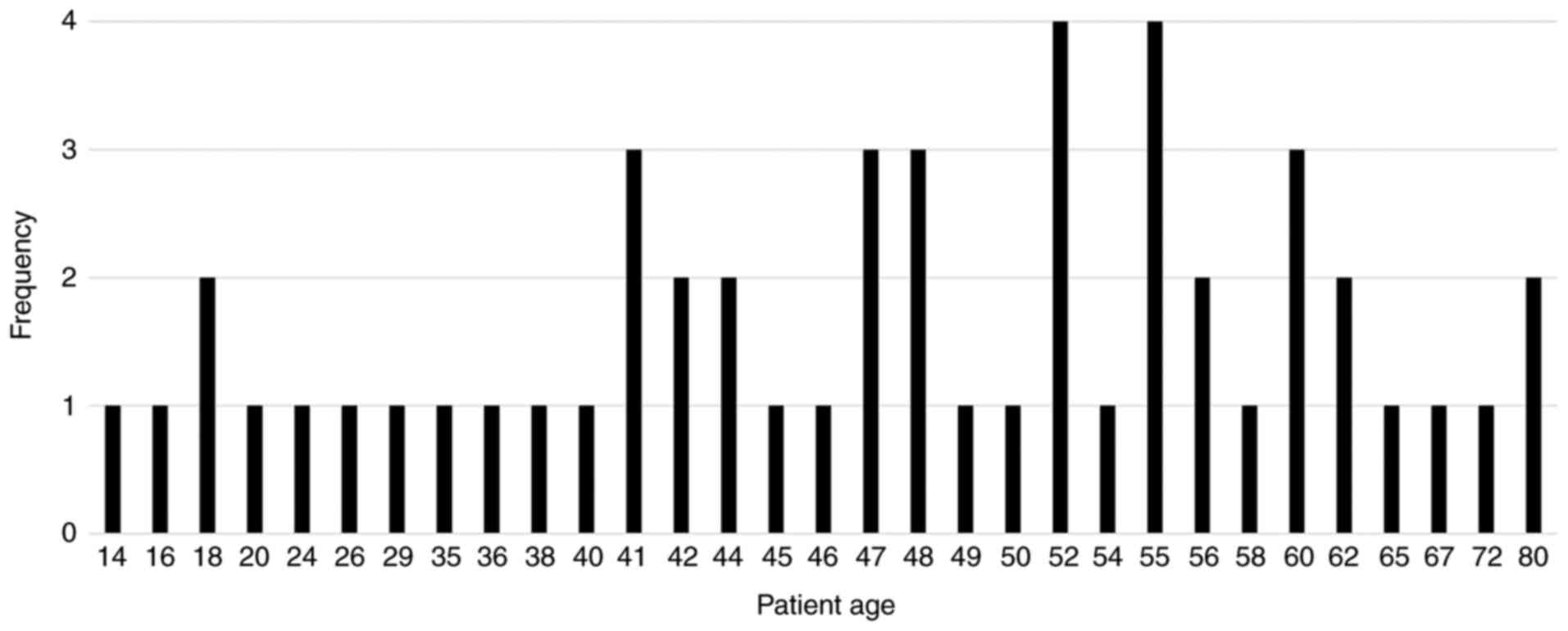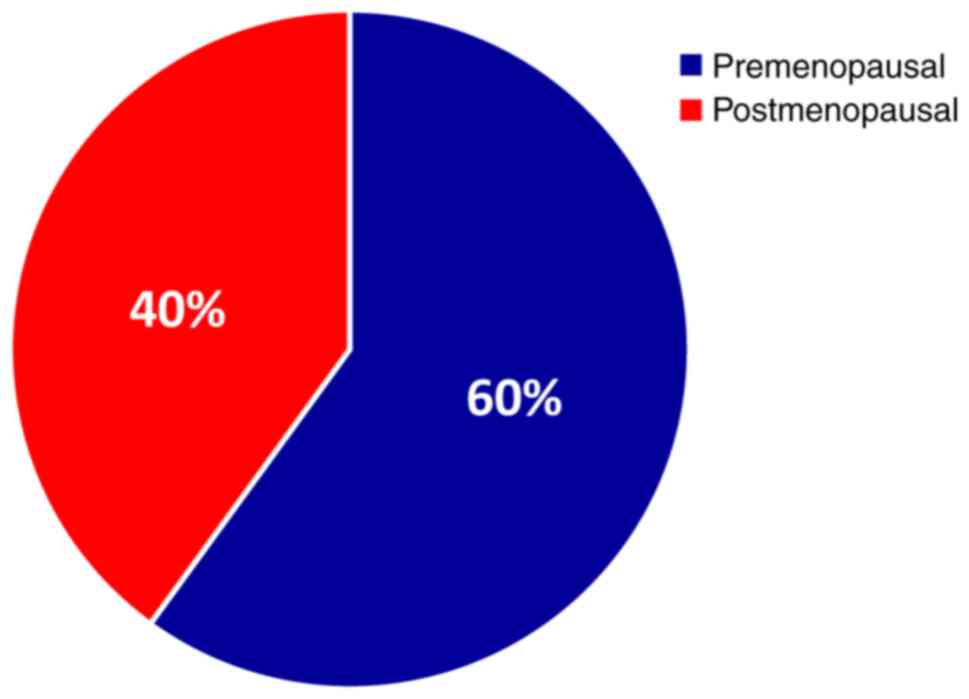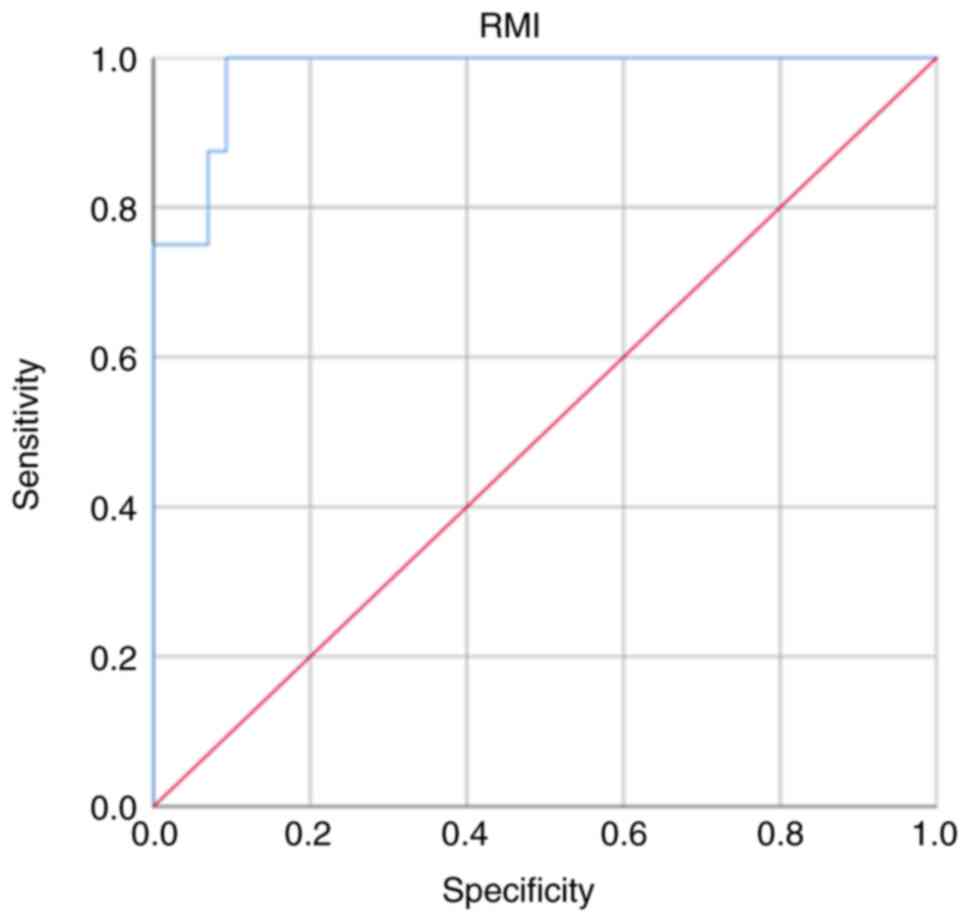|
1
|
Group UCSW: United States cancer
statistics: 1999-2010 incidence and mortality web-based report.
Atlanta: US Department of Health and Human Services, Centers for
Disease Control and Prevention and National Cancer Institute 201,
2013.
|
|
2
|
GBD 2015 Mortality and Causes of Death
Collaborators: Global, regional, and national life expectancy,
all-cause mortality, and cause-specific mortality for 249 causes of
death, 1980-2015: A systematic analysis for the global burden of
disease study 2015. Lancet. 388:1459–1544. 2016.PubMed/NCBI View Article : Google Scholar
|
|
3
|
Wild CP, Stewart BW and Wild C: World
Cancer Report 2014. World Health Organization, Switzerland,
2014.
|
|
4
|
Coburn SB, Bray F, Sherman ME and Trabert
B: International patterns and trends in ovarian cancer incidence,
overall and by histologic subtype. Int J Cancer. 140:2451–2460.
2017.PubMed/NCBI View Article : Google Scholar
|
|
5
|
Rossing MA, Wicklund KG, Cushing-Haugen KL
and Weiss NS: Predictive value of symptoms for early detection of
ovarian cancer. J Natl Cancer Inst. 102:222–229. 2010.PubMed/NCBI View Article : Google Scholar
|
|
6
|
Hoffman BL, Schorge JO, Schaffer JI,
Halvorson LM, Bradshaw KD and Cunningham FG: Epithelial ovarian
cancer. In: Williams Gynecology. 2nd edition. McGraw-Hill,
pp853-878, 2012.
|
|
7
|
Jayson GC, Kohn EC, Kitchener HC and
Ledermann JA: Ovarian cancer. Lancet. 384:1376–1388.
2014.PubMed/NCBI View Article : Google Scholar
|
|
8
|
No authors listed: Surveillance Report
(Exceptional Review) 2017-Ovarian Cancer: Recognition and initial
management (2011) NICE guideline CG122. National Institute for
Health and Care Excellence, London, 2017.
|
|
9
|
Javdekar R and Maitra N: Risk of
malignancy index (RMI) in evaluation of adnexal mass. J Obstet
Gynaecol India. 65:117–121. 2015.PubMed/NCBI View Article : Google Scholar
|
|
10
|
Andersen ES, Knudsen A, Rix P and Johansen
B: Risk of malignancy index in the preoperative evaluation of
patients with adnexal masses. Gynecol Oncol. 90:109–112.
2003.PubMed/NCBI View Article : Google Scholar
|
|
11
|
Terzić M, Dotlić J, Ladjević IL,
Atanacković J and Ladjević N: Evaluation of the risk malignancy
index diagnostic value in patients with adnexal masses. Vojnosanit
Pregl. 68:589–593. 2011.PubMed/NCBI View Article : Google Scholar
|
|
12
|
Moolthiya W and Yuenyao P: The risk of
malignancy index (RMI) in diagnosis of ovarian malignancy. Asian
Pac J Cancer Prev. 10:865–868. 2009.PubMed/NCBI
|
|
13
|
Akdeniz N, Kuyumcuoğlu U, Kale A,
Erdemoğlu M and Caca F: Risk of malignancy index for adnexal
masses. Eur J Gynaecol Oncol. 30:178–180. 2009.PubMed/NCBI
|
|
14
|
Escudero JM, Auge JM, Filella X, Torne A,
Pahisa J and Molina R: Comparison of serum human epididymis protein
4 with cancer antigen 125 as a tumor marker in patients with
malignant and nonmalignant diseases. Clin Chem. 57:1534–1544.
2011.PubMed/NCBI View Article : Google Scholar
|
|
15
|
Myers ER, Bastian LA, Havrilesky LJ,
Kulasingam SL, Terplan MS, Cline KE, Gray RN and McCrory DC:
Management of adnexal mass. Evid Rep Technol Assess (Full Rep)
1-145, 2006.
|
|
16
|
Bindal J and Bankey S: Prevalence of
ovarian tumours among ovarian mass lesions in Gajra Raja Medical
College, Gwalior, India. Int J Reprod Contracept Obstet Gynecol.
6:3907–3911. 2017.
|
|
17
|
Jha R and Karki S: Histological pattern of
ovarian tumors and their age distribution. Nepal Med Coll J.
10:81–85. 2008.PubMed/NCBI
|
|
18
|
McGuire V, Hartge P, Liao LM, Sinha R,
Bernstein L, Canchola AJ, Anderson GL, Stefanick ML and Whittemore
AS: Parity and oral contraceptive use in relation to ovarian cancer
risk in older women. Cancer Epidemiol Biomarkers Prev.
25:1059–1063. 2016.PubMed/NCBI View Article : Google Scholar
|
|
19
|
Al-Musalhi K, Al-Kindi M, Ramadhan F,
Al-Rawahi T, Al-Hatali K and Mula-Abed WA: Validity of Cancer
Antigen-125 (CA-125) and risk of malignancy index (RMI) in the
diagnosis of ovarian cancer. Oman Med J. 30:428–434.
2015.PubMed/NCBI View Article : Google Scholar
|
|
20
|
Liu J, Xu Y and Wang J: Ultrasonography,
computed tomography and magnetic resonance imaging for diagnosis of
ovarian carcinoma. Eur J Radiol. 62:328–334. 2007.PubMed/NCBI View Article : Google Scholar
|
|
21
|
Radiology ACo: ACR Appropriateness
Criteria 2008: Clinically suspected adnexal mass. American College
of Radiology Web site. Available from: http://www.acr.org/SecondaryMainMenuCategories/quality_safety/app_criteria/pdf/ExpertPanelonWomenImaging/SuspectedAdnexalMasses-Doc11.
Accessed November 9, 2009.
|
|
22
|
Valentin L, Ameye L, Jurkovic D, Metzger
U, Lécuru F, Van Huffel S and Timmerman D: Which extrauterine
pelvic masses are difficult to correctly classify as benign or
malignant on the basis of ultrasound findings and is there a way of
making a correct diagnosis? Ultrasound Obstet Gynecol. 27:438–444.
2006.PubMed/NCBI View
Article : Google Scholar
|
|
23
|
Patel MD: Practical approach to the
adnexal mass. Radiol Clin North Am. 44:879–899. 2006.PubMed/NCBI View Article : Google Scholar
|
|
24
|
Rein BJ, Gupta S, Dada R, Safi J, Michener
C and Agarwal A: Potential markers for detection and monitoring of
ovarian cancer. J Oncol. 2011(475983)2011.PubMed/NCBI View Article : Google Scholar
|
|
25
|
Nazneen T, Begum SA, Mahmud T, Khatoon F,
Islam F and Amatullah M: Preoperative analysis of CA-I25 and its
relation with histopathological study in ovarian tumours.
Mymensingh Med J. 30:402–409. 2021.PubMed/NCBI
|
|
26
|
Liao XY, Huang GJ, Gao C and Wang GH: A
meta-analysis of serum cancer antigen 125 array for diagnosis of
ovarian cancer in Chinese. J Cancer Res Ther. (Suppl 10):C222–C224.
2014.PubMed/NCBI View Article : Google Scholar
|
|
27
|
Van Calster B, Timmerman D, Valentin L,
McIndoe A, Ghaem-Maghami S, Testa AC, Vergote I and Bourne T:
Triaging women with ovarian masses for surgery: Observational
diagnostic study to compare RCOG guidelines with an international
ovarian tumour analysis (IOTA) group protocol. BJOG. 119:662–671.
2012.PubMed/NCBI View Article : Google Scholar
|
|
28
|
Ulusoy S, Akbayir O, Numanoglu C, Ulusoy
N, Odabas E and Gulkilik A: The risk of malignancy index in
discrimination of adnexal masses. Int J Gynaecol Obstet.
96:186–191. 2007.PubMed/NCBI View Article : Google Scholar
|
|
29
|
Chia YN, Marsden DE, Robertson G and
Hacker NF: Triage of ovarian masses. Aust N Z J Obstet Gynaecol.
48:322–328. 2008.PubMed/NCBI View Article : Google Scholar
|

















